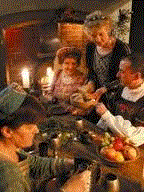The History of Ruthin Castle
A notorious Welsh stronghold boasting a fascinating history dating back prior to 1277; Ruthin Castle was once a wooden fort that according to folklore was frequented by the likes of King Arthur. The journey to the romantic hotel that she is today has involved kings, queens, nobility and some epic mediaeval adventures along the way.
The Fighting Years
In the years that followed the mediaeval castle played a fundamental role in defending the region until 1402 when Reginald de Grey (a descendant of the original), was captured and ransomed by Owain Glyndwr. This resulted in the castle’s sale to the Crown Estate in 1508 where it remained in the ownership of Henry VIII, Elizabeth I and many other monarchs until it was sold by Charles I in 1632. Soon after in 1646, parliamentary forces of the Civil War made Ruthin Castle their target and fierce battles ensued with an 11 week long siege seeing the forces seize control before ordering large parts of the castle to be demolished. Sections of battle scarred mediaeval walls, tunnels and underground dungeons survived with their secrets of torture and bravery, and are today listed as ‘Scheduled Ancient Monuments’.
Legend, Romance & Tragedy
Legend also has it that the wife of an army commander of Edward I discovered her husband’s romantic affair with a local girl and in a passionate rage murdered her with an axe. For her bloody deed she was executed, prohibited from being buried in consecrated ground and therefore buried by the castle walls. Her stone grave still exists and it is said that she forever roams the battlements as the ghostly ‘grey lady’.
The modern stone castle was built within the mediaeval stone castle ruins in 1826, and gained most fame when owned by the Cornwallis-West family and became the center of dangerous romantic intrigue at the highest level. Colonel Cornwallis-West’s wife ‘Patsy’ is said to have become embroiled in a long love affair with Edward, Prince of Wales (later becoming Edward VII). Beautiful Patsy was just 16 years old when she married and was at the height of society, notorious as a flirt, and full of the joys of life. Her favourite party trick was to toboggan down the castle stairs on a tea tray in the presence of the future King.
Patsy entertained numerous noted guests at Ruthin Castle including Lady Randolph Churchill (mother of Sir Winston Churchill) and the actress Lillie Langtry, both of whom also had romantic affairs with the Prince of Wales. Lady Randolph Churchill later married Patsy’s son, George, 20 years her younger and owner of the castle at that time.
Patsy also had two daughters, Shelagh, who married the powerful Duke of Westminster, and Daisy who fell in love with her own Prince, Hans Heinrich of Pless, part of a family owning enormous estates in south-eastern Germany and considered ‘fabulously wealthy’. Hers was a fairytale wedding attended by world royalty, nobility, statesmen and members of high society. When she arrived at her new home the streets were lined with crowds for miles and she developed a reputation similar to that more recently of Diana, Princess of Wales. Tragically the events of World War I turned Princess Daisy’s world upside down and resulted in divorce, bad health and death in poverty.
|
||||
 |
 |
 |
||